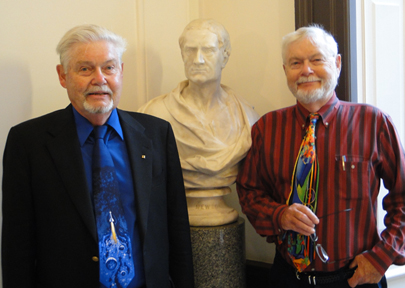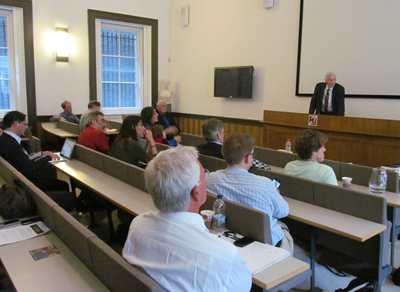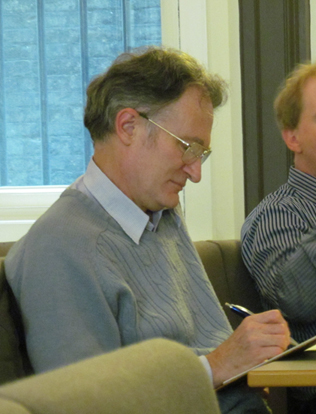= ASTRONAUTICAL EVOLUTION =
Issue 96, 1 November 2013 – 44th Apollo Anniversary Year
=============== AE ===============
Highlights from the Starship Century Symposium in London
Stephen Ashworth, Oxford, UK
This report first appeared on the Centauri Dreams blog on 28 October 2013.
Is this the century of the starship?
The new book Starship Century, edited by physicists James and Gregory Benford and with contributions from many active in the interstellar field, takes a broad view of questions of interstellar exploration, the editors told this meeting at the Royal Astronomical Society in London on 21 October 2013. In the first place, why has there been such a surge of interest over the past decade or so, with several new organisations devoted to interstellar travel appearing on the scene? Is the 21st the century humanity will build starships, and if so, why and how?

With Voyager 1 now having crossed the heliopause and New Horizons due to make its flyby of Pluto in less than two years time, finishing the initial reconnaissance of the Solar System, together with a flood of exoplanet discoveries, including the first indications of a planet in the Alpha Centauri system, the time appears right for interstellar exploration to inspire growing interest, James Benford said in his introductory talk.
Yet the task is immense. Before our ancestors learned to ride horses, they were only able to move at a walking speed, on the order of a metre per second. The Apollo astronauts departed from and returned to Earth at speeds around 104 times faster. A cruising speed of a significant fraction of the speed of light, necessary to reach the stars in a reasonable period of time, would require another 104 times jump.
Moreover, in order to make that jump one is running up against the limits of known energy sources. An object flying at 3.75% of light speed possesses the same kinetic energy per kilogram of mass as that released in a thermonuclear explosion.
In an article in Physics Today back in 1968, Freeman Dyson predicted that the first interstellar voyages would be possible in 200 years time. However, he recently reiterated that they would still be possible in 200 years time – the familiar tale of an ever-receding goal. Harnessing the immense energies of nuclear fusion reactions, whether for commercial power generation or for rocket propulsion, is not turning out to be easy.
What about the attitude of the public? Benford displayed a cartoon: an ascending sequence of technological achievements in chronological order – a horse-drawn wagon, a car, a locomotive, an aircraft, a space rocket – as rough drawings on a wall. Then you notice that the artist is a caveman. Then zoom out, and you see a cavewoman watching him skeptically, and asking him when he’s going to get the meat in for their dinner. The triumphalist belief in inevitable progress is a nerdish pursuit, and the majority of the public can see no further than the desire to solve their day to day problems.
(However, in The Demon-Haunted World Carl Sagan wrote of the critical importance of those denigrated as “nerds” in making progress possible – his example was James Clerk Maxwell. – Comments in parentheses such as this are my personal reflections after the event.)
For the present, interstellar progress is in the hands of six private groups, all with very small budgets: the British Interplanetary Society (the oldest, founded in 1933), the Tau Zero Foundation, Icarus Interstellar, the 100 Year Starship Organization, the Institute for Interstellar Studies, and most recently the New Horizons Message Initiative. (Given its website and organisation of meetings such as this one, surely Starship Century itself counts as the seventh group?)
Cascading opportunities among a galaxy of planets
James Benford’s brother Gregory presented a quotation about the prospect for development of North America from Thomas Jefferson back in 1812: “It will take a thousand years for the frontier to reach the Pacific.” Jefferson was assuming that colonists would be limited to the capabilities of horse-drawn wagons, yet the steam engine was already a reality, and communications across the continent were vastly accelerated when the trans-continental railroad was completed in 1869.
So Jefferson’s estimate was out by more than an order of magnitude. It didn’t occur to him that opportunities in technology and the economy would cascade to drive settlement of the interior. In a similar way, during the coming century we could be seeing a combination of nuclear rockets, robotics and 3D printing working together to accelerate the economic opening up of the Solar System, which will be essential to exploring beyond it.
Ian Crawford, professor of astronomy at Birkbeck College, London, displayed a plot of exoplanet discoveries made by the Kepler mission (see image at the top of this page), the conclusion of which had to be that virtually all main-sequence stars do in fact have planets of one sort or another. But because it is easier to find them by the transit method, only four are currently known (with varying levels of reliability) within 15 light-years of the Sun, orbiting Alpha Centauri B, Tau Ceti, Epsilon Eridani, and the red dwarf GJ 674.
More nearby planets will surely be discovered as techniques improve, with the James Webb Space Telescope, the Transiting Exoplanet Survey Satellite (TESS, the planned successor to Kepler) and Europe’s Exoplanet Characterisation Observatory (EChO) in prospect, as well as continuing improvements in adaptive optics applied to large ground-based telescopes.
The ideal tool would be something like Europe’s Darwin space interferometer, which would be capable of obtaining the spectra of Earthlike exoplanets. But Darwin is not currently under development. And, as Charles Cockell has pointed out, even if the spectra of gases associated on Earth with life (H2O, CO2, O3) are obtained, they would not definitively prove that life had to be present, nor would they tell us anything about the nature of that life if it existed. The spectrum of Earth must have appeared much the same over the past two billion years, through dramatically different epochs of its biological history.
The only way to be sure would be to send an interstellar probe that could make in-situ measurements. Crawford presented his shopping list for the instruments he would like to carry on that probe, with a whole array of orbiters, landers and atmospheric entry probes, arriving at a mass decelerated into the target system in the range of 150 to 200 tonnes.
But his reasons for interstellar exploration extend beyond science. He presented arguments from the seventeenth-century philosopher John Locke, who reasoned that the human imagination cannot produce anything genuinely new. In order to refresh both science and our broader culture, therefore, it is necessary to go out and physically discover genuinely new things. Interstellar exploration more than any other pursuit puts us on track to discover things that have never been thought of before.
Stephen Baxter, the well-known science fiction author and, like Crawford, an Icarus team member, discussed what might happen if one of our interstellar probes were to encounter intelligence at its destination. On the assumption that we had not known of the existence of intelligent life there when the probe was despatched, contact would take place when the vehicle was remote from any direct human control. How would it detect and recognise alien intelligence, and how might it be programmed to respond?
Of course, the extraterrestrials might see our vehicle arriving, and Baxter discussed ways in which this might come about. (Implausible, I thought: if they were that technically advanced, they would surely have visited us long before. The time window in which they are developed enough to detect, say, the exhaust from the fusion engine of a decelerating vehicle, and to recognise it for what it is, but not developed enough to be launching their own interstellar vehicles, would be only a few centuries at most in the history of a species whose origin is not coordinated with that of H. sapiens and might well be millions to billions of years earlier or later.)
These issues are presented in more detail in Baxter’s article in the Jan./Feb. 2013 issue of JBIS. He also noted that his own latest novel, Proxima, is, appropriately enough, an interstellar yarn.
The word from the A.R.
(I don’t know if people still call the Astronomer Royal “A.R.”, but I did re-read Fred Hoyle’s classic The Black Cloud not so long ago, and they certainly did then.)
Lord Martin Rees, the Astronomer Royal, has written extensively on the cosmos and the outlook for human civilisation. He brought an astronomer’s perspective on time to the Symposium, particularly future time: assuming we do not become extinct, post-human evolution will be much longer than that which led up to us, and will moreover be accelerated and directed in new ways by genetic and computer technologies. So far as our evolution is concerned, we have not yet reached even the halfway point.

What role, he asked, will humans play in space? In contrast with Ian Crawford’s well-known view, he did not see any case for astronauts as scientific explorers in an age of increasingly capable robots. But the human adventure of space travel in person was undeniable. He gave two pointers to the human future in space: China might leapfrog the US and send astronauts to Mars, and meanwhile the private sector was also on the verge of sending passengers into space. NASA had become risk-averse, creating an opportunity for privately funded adventurers who were willing to accept greater levels of risk – not as “space tourists”, for that phrase gives a misleading impression of safety and regularity, but as participants in a dangerous sport akin to deep ocean diving or making the ascent of Everest.
(I would disagree with the A.R. on two points here. Having already experienced the disappointment of seeing Soviet cosmonauts fail to reach the Moon, I do not share the enthusiasm for Chinese manned spaceflight. They are currently about where the two traditional superpowers were before the Salyut 6 breakthrough in the late 1970s. I have heard no reason why a Chinese Apollo, Shuttle or continuously occupied Station programme, were such to appear, would be any more sustainable than their American and Russian originals, and they are nowhere near even beginning the major structural reorganisation currently underway across the Atlantic, essential for meaningful progress at this point. Meanwhile, although we do not yet have space tourism as such, the creation of a mass market for space travel at a level of at least 5,000 passengers/year worldwide (say, one planeload of 20 every weekday of the year) at near-airline standards of service seems to me to be vital for consolidating our hold on low Earth orbit, bringing the costs down and reliability up to levels that allow for sustained exploration beyond near-Earth space.)
Lord Rees stated, reasonably enough, that there would never be mass emigration from Earth, and so Earth’s problems would have to be solved on their own terms. But by the end of the current century there could well be small groups of pioneers living away from the mother planet. Interstellar travel, however, is for post-humans, whether genetically modified but still biological humans, or entirely manufactured beings.
He pointed out that explorers of our own planet were in some ways going into the unknown to a far greater extent than astronauts ever will. They were crossing oceans and continents about which nothing was known but much was imagined, completely out of touch with their port of origin, unlike any astronaut, whose journey takes them to lands already surveyed by telescope and probed by robot precursors, and in direct line of sight radio communication (if delayed by light travel time) with Earth. But what terrestrial explorers did have was a high expectation of profitable discoveries leading them ever onward.
As an astronomer, Lord Rees was naturally no stranger to the longest possible future perspectives, when the apparently accelerating cosmological expansion has carried almost all the universe beyond our horizon, leaving only the matter in the Local Group of galaxies accessible to our remote descendants. Maybe they would find that they were living in only one universe in a multiverse, or in someone else’s simulated universe.
General discussion
The presentations were followed by general discussion. There was some debate about the key factors in our intelligence, and in that of any intelligent alien species which we might meet elsewhere in the Galaxy. Biologist and science fiction author Paul McAuley pointed out that species other than ourselves use and make tools, and suggested that the key to our success had been our ability to archive knowledge for future generations to use.
(My own view is that an archive, such as a library containing books, is itself a kind of tool, so that does not answer the question. My answer would be that we are unique in that we not only use and make tools, but that critically we use tools to make better tools. It is this recursive use of technology back onto itself in order to make better technology that is what drives progress.)

I should like to draw particular attention to what was said about the near-term future, before an interstellar mission is even launched. For it is what happens on Earth and in space over the next few years which will determine whether or not our civilisation even has an interstellar future.
Ian Crawford made the point that the single most important factor was to reduce the cost of access from Earth’s surface to orbit, whether this was done with single-stage-to-orbit spaceplanes, or by construction of a space elevator. (Here let me link to the latest news on Britain’s Skylon spaceplane programme, managed by interstellar pioneer Alan Bond of Daedalus and worldships fame.)
James Benford argued for nuclear rockets, firstly fission engines of the type developed by NASA in the late 1960s, later fusion engines, which would open up the Solar System. SpaceX, he agreed, would surely succeed in lowering costs, but in his view there was also a case for beamed power for access to space. His brother cautioned that the laser-ignition fusion work in which he had been involved forty years previously had still not achieved a useful result, but that there were good prospects for fusion based on the proton-boron reaction. Stephen Baxter proposed that large-scale geoengineering projects, such as building a solar parasol to keep Earth cool, or the large-scale development of solar power satellites, might be an important driver of progress.
The debate over whether space agencies or the private sector are in the better position to lead produced a number of points. Governments are broke, James Benford said, hence the private sector must lead. (He was clearly not claiming that they are literally bankrupt, but rather that they are under financial pressure, in which case their resources go preferentially to defence, social security and the currently fashionable attempt to control the global climate, while space exploration gets short shrift and poor leadership.)
Governments are risk-averse, Lord Rees added, leading to the same conclusion – new moves will be spearheaded by crazy billionaires, leading small groups of eccentric but highly motivated people (perhaps thinking of Dennis Tito’s Inspiration Mars project). In his view, this would be no bad thing: we should encourage everyone to explore the limits of what humans can do.
But Gregory Benford (whose novel The Martian Race features the Chinese government competing, with European collaboration, in a race to Mars) allowed a possible leading role for government in the case of China.
Ian Crawford cautioned that space could not be allowed to become a free-for-all because of the dangers involved when, for example, asteroidal material impacts Earth. One could imagine a private group holding Earth to ransom in this way. It would therefore be necessary for us to evolve appropriate political institutions to ensure that space development is beneficial for all.
James Benford picked up this theme, stating that what governments can do is to make developments possible, or impossible. In the case of railways and canals they set up rights of way, for example by the purchase of land for the trans-continental railroad across the United States. Clearly, governments are also the guarantors of private property, and of the whole system of law and order on which economic prosperity depends. A creative synergy between government and private enterprise is therefore surely the way forward.
Next step: read the book!
In summary, then, this was a stimulating meeting with several of the key thinkers in the interstellar field. It was an excellent opportunity for people in Britain like myself who cannot hop across the Atlantic to attend interstellar conferences in the US, and it deserved to have been more fully attended (as it was, there were seats to spare in the smallish auditorium where the meeting took place).
The breadth and confidence of the vision of humanity’s and post-humanity’s interstellar future, presented in this and many other conferences, contrasts oddly with the current confusion and controversy about the direction of the public space programme in the United States, and with the apathy and stagnation in Europe. Clearly a major reorganisation of the space industry is under way, leading towards a more economically based industry in which government is one customer among many, as is already the case for Earth satellites but not yet the case for manned spaceflight, or for robotic ventures beyond geostationary orbit.
More details and discussion, from the speakers at this meeting and many others, may be found in the Starship Century book.
My thanks to the Benfords and to our hosts at the Royal Astronomical Society for organising this event.